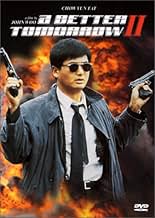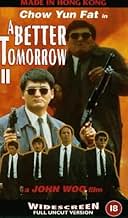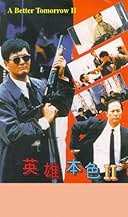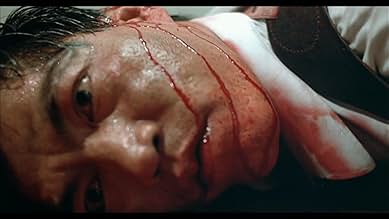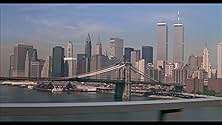AVALIAÇÃO DA IMDb
7,2/10
12 mil
SUA AVALIAÇÃO
Adicionar um enredo no seu idiomaA restauranteur teams up with a police officer and his ex-con brother to avenge the death of a friend's daughter.A restauranteur teams up with a police officer and his ex-con brother to avenge the death of a friend's daughter.A restauranteur teams up with a police officer and his ex-con brother to avenge the death of a friend's daughter.
- Direção
- Roteiristas
- Artistas
- Prêmios
- 2 indicações no total
Chow Yun-Fat
- Ken
- (as Chow Yun Fat)
- …
Lung Ti
- Sung Tse-Ho
- (as Ti Lung)
Shing Fui-On
- Pui's Right-Hand Man
- (as Fui-On Shing)
Avaliações em destaque
Chow Yun-Fat is back, teaming up the cop "Kit" and ex-con "Ho" to deal some serious whup-ass on a gang of thugs, for killing their friend's daughter.
This one's not John Woo's best but it's still great in the genre of HK cop movies. The first half is not as good as the second, with some plot holes and kind of weird scenes establishing the state of mind of their friend (whose daughter was killed). Not to give anything away but - you will see what I mean.
Better Tomorrow II proves that nobody looks cooler wielding a 12-gauge shotgun than Chow Yun-Fat (ok, maybe Schwarzeneggar in T2).
The final gun battle at Ko's mansion is phenomenal - it gives Scarface a run for its money in terms of body count and ropes of blood splashing on walls. I love Woo's explosive style of close gun battles and over-the-top carnage. I mean, is it really necessary, once pumping 2 lethal rounds into the bad guy's chest thus assuring his death, to empty the clips from both handguns into him as he is staggering back? Better Tomorrow II states emphatically - YES!
This one's not John Woo's best but it's still great in the genre of HK cop movies. The first half is not as good as the second, with some plot holes and kind of weird scenes establishing the state of mind of their friend (whose daughter was killed). Not to give anything away but - you will see what I mean.
Better Tomorrow II proves that nobody looks cooler wielding a 12-gauge shotgun than Chow Yun-Fat (ok, maybe Schwarzeneggar in T2).
The final gun battle at Ko's mansion is phenomenal - it gives Scarface a run for its money in terms of body count and ropes of blood splashing on walls. I love Woo's explosive style of close gun battles and over-the-top carnage. I mean, is it really necessary, once pumping 2 lethal rounds into the bad guy's chest thus assuring his death, to empty the clips from both handguns into him as he is staggering back? Better Tomorrow II states emphatically - YES!
10Azzy
I have seen true ultra-violence in films many times in my life, but the last 10 minutes of this movie surpasses anything I have ever seen or imagined. men are mowed down by the hundreds, blood splattering every which way in frighteningly large volumes. it exceeds even the hospital shootout in Hard Boiled, which took four times as long. It is also more inventive than most of John Woo's gunfights (I am NOT critisizing his other works!!!). The heroes use grenades and swords. Two parts stand out from this amazing carnage. The first is Ti lung's smash up with shing fu on. swords and axes, guts and glass, everything goes flying. The second is the duel between Chow Yun-Fat and Chong, The silent mafioso killer. Their Gun trade is a classic. The rest of the movie is pretty cool, including a gunfight in a Brooklyn hotel, Ala Taxi Driver, and a scene where Chow Yun-Fat makes fun of the fetishized Better Tomorrow dress.
After the movie 'A Better Tomorrow' became a big success around Hong Kong, a sequel was inevitable to happen. Most of the original cast return, including Chow Yun-Fat as Mark Lee's twin brother Ken.
Taking place a few years after the events of the first film, we see how things are finally starting to look up. Ho is in prison but he's finally re concealed his relationship with his brother Kit, who has become a loving husband and soon to be father. But like the first film, things get bad real quick. Ho's former master Lung has been framed for murder and even loses his mind as his life gets worse. He's sent over to New York to keep a low profile and to be looked after by Ken who owns a restaurant and lives there. Meanwhile Ho and Kit are working together to end the triad gangs.
This is where the problem starts. The first film revolved around Ho and the people around him, but this film spends way too much time with Ken trying to get Lung back to normal. Ho and Kit's plot seems to delve deeper into the main story ark, yet they never seem to get enough scenes. Ken is pretty much similar to Mark although he may be a little darker and you can tell he's only in the film because of Chow Yun-Fat's character was so popular in the last film.
The film doesn't seem to make a huge continuation onto the first film either. Instead of being it's own story, it seems to just be an expansion of the first film, but not in a good way. We don't delve too much into the characters and they seem underused. The film is also known for having a sillier feel in a few scenes(Famous Rice Scene), but it didn't ruin the experience for me. These flaws are apparently due to disagreement between John Woo and producer/second writer Tsui Hark about the tone of the film, causing Woo to disown most of the film, except the end shootout. John Woo's original cut was around 3 hours and is rumoured to improve on some of the flawed moments. A version I hope will appear in some future release of the film.
Now for the goods. The film seems to get noticeable better during the second half, beginning with the amazing hotel shootout. The film is well known for it's exaggerated violence and blood and the film doesn't disappoint. The action is a big step up from the first and some of the best ever filmed for its time. Chow Yun-Fat is once again cooler than ice, with his trademark sunglasses, trench coat, matchstick and dual pistols and may be one of the main appeals of the film. The Climatic assault on the triad mansion is one of the greatest shootouts and one of the greatest ending ever filmed. It's no wonder that it's the only thing Woo likes about the film. The amazing soundtrack returns and their are a few emotional scenes that actually work well.
With many iconic scenes (The stairs scene being one), the film is a lot better than it gets credit for. The film is no masterpiece and doesn't compare to the first but it has its moments. Silly and flawed moments aside the film is actually quite enjoyable and as long as you keep an open mind, I think you'll enjoy this conclusion to the Better Tomorrow saga. Part 3 doesn't count!
Taking place a few years after the events of the first film, we see how things are finally starting to look up. Ho is in prison but he's finally re concealed his relationship with his brother Kit, who has become a loving husband and soon to be father. But like the first film, things get bad real quick. Ho's former master Lung has been framed for murder and even loses his mind as his life gets worse. He's sent over to New York to keep a low profile and to be looked after by Ken who owns a restaurant and lives there. Meanwhile Ho and Kit are working together to end the triad gangs.
This is where the problem starts. The first film revolved around Ho and the people around him, but this film spends way too much time with Ken trying to get Lung back to normal. Ho and Kit's plot seems to delve deeper into the main story ark, yet they never seem to get enough scenes. Ken is pretty much similar to Mark although he may be a little darker and you can tell he's only in the film because of Chow Yun-Fat's character was so popular in the last film.
The film doesn't seem to make a huge continuation onto the first film either. Instead of being it's own story, it seems to just be an expansion of the first film, but not in a good way. We don't delve too much into the characters and they seem underused. The film is also known for having a sillier feel in a few scenes(Famous Rice Scene), but it didn't ruin the experience for me. These flaws are apparently due to disagreement between John Woo and producer/second writer Tsui Hark about the tone of the film, causing Woo to disown most of the film, except the end shootout. John Woo's original cut was around 3 hours and is rumoured to improve on some of the flawed moments. A version I hope will appear in some future release of the film.
Now for the goods. The film seems to get noticeable better during the second half, beginning with the amazing hotel shootout. The film is well known for it's exaggerated violence and blood and the film doesn't disappoint. The action is a big step up from the first and some of the best ever filmed for its time. Chow Yun-Fat is once again cooler than ice, with his trademark sunglasses, trench coat, matchstick and dual pistols and may be one of the main appeals of the film. The Climatic assault on the triad mansion is one of the greatest shootouts and one of the greatest ending ever filmed. It's no wonder that it's the only thing Woo likes about the film. The amazing soundtrack returns and their are a few emotional scenes that actually work well.
With many iconic scenes (The stairs scene being one), the film is a lot better than it gets credit for. The film is no masterpiece and doesn't compare to the first but it has its moments. Silly and flawed moments aside the film is actually quite enjoyable and as long as you keep an open mind, I think you'll enjoy this conclusion to the Better Tomorrow saga. Part 3 doesn't count!
A Better Tomorrow II (1987) was rushed into production after the success of the first film. Armed with a bigger budget, Cinema City forged ahead with this sequel. Following after the events of part one. Lung Ti is about to be released from prison when he's offered a job as an undercover agent. His mission is to find some criminal evidence to topple his former boss (Cinema City board member Dean Shek). A first he dismisses the gig until he realizes they're going to his eager younger brother (Leslie Cheung). Once Lung is out, he notices that everything is not quite as it seems.
An interesting film. This time Tsui Hark had more of a hand in the production. He included his friend Dean Shek into the movie and he employed his best action director (Ching Siu-Tung) to direct the over-the-top action scenes. John Woo wasn't pleased with this and he voiced his displeasure. The final rift came during the editing of the film. Tsui Hark wanted the movie to be under two hours so it could have more showings, John Woo wanted it to be an epic. Guess who one out? Say what you will about this film, the action scenes are pure Ching Siu-Tung. His wild action scenes made this movie. Mr. Tsui must have liked him a lot because he went on to choreograph the action scenes in The Killer (although he was credited with stunt coordinator the action scenes have all of his visual trademarks).
The budget was huge on this one. It was filmed in Hong Kong and in the United States. Tsui Hark had another one of his friends (Peter Wang) co-star in the movie as well (he plays the inner city priest Dean Shek meets in N.Y.C.). Despite the friction caused by the behind the scenes squabbling, A Better Tomorrow II is a magnificent exercise in the ultra-violence. Awesome!
Highly recommended.
The last film in the trilogy is the epic A Better Tomorrow III: Love and death in Saigon.
An interesting film. This time Tsui Hark had more of a hand in the production. He included his friend Dean Shek into the movie and he employed his best action director (Ching Siu-Tung) to direct the over-the-top action scenes. John Woo wasn't pleased with this and he voiced his displeasure. The final rift came during the editing of the film. Tsui Hark wanted the movie to be under two hours so it could have more showings, John Woo wanted it to be an epic. Guess who one out? Say what you will about this film, the action scenes are pure Ching Siu-Tung. His wild action scenes made this movie. Mr. Tsui must have liked him a lot because he went on to choreograph the action scenes in The Killer (although he was credited with stunt coordinator the action scenes have all of his visual trademarks).
The budget was huge on this one. It was filmed in Hong Kong and in the United States. Tsui Hark had another one of his friends (Peter Wang) co-star in the movie as well (he plays the inner city priest Dean Shek meets in N.Y.C.). Despite the friction caused by the behind the scenes squabbling, A Better Tomorrow II is a magnificent exercise in the ultra-violence. Awesome!
Highly recommended.
The last film in the trilogy is the epic A Better Tomorrow III: Love and death in Saigon.
This film broke off a potentially very creative relationship between Tsui hark and John Woo; and it certainly feels like more than one film Certainly, until Chow Yun Fat shows up, the plot is a little complicated, and a little unbelievable. Once Chow appears, the plot becomes wildly unbelievable, but one can follow it with amusement and interest. Ti lung must also be credited with turning in a strong and well-grounded performance, even when the script calls for him to get schmaltzy.
This is also the film that salvaged character actor dean Shek from obscurity, he wanted to prove he could act, and though he over acts occasionally, he actually does pretty well, especially in the final gun battle.
It must be said that throughout his career, John Woo has repeatedly attempted to grasp the essence of the 'battle of bloody porch' from Sam Peckinpah's "the Wild Bunch" and duplicate it - and he has always failed. that's because (to be honest) Woo is a believing Christian; and although raised in the Calvinist tradition, Peckinpah clearly does not believe. Woo simply cannot grasp the basics of Peckinpah's existentialism.
Consequently, the final battle here, while a lot of gory fun, doesn't really make the point Woo clearly wants for it (which is a believing Christian's interpretation of the Wild Bunch), but - never mind. On its own terms, as I say, it's quite fun.
As for the 'serious' story concerning the young undercover cop and his pregnant wife, I didn't believe it for a moment, and, frankly, didn't care. I'm afraid I'm not a believing Christian, either.
This is also the film that salvaged character actor dean Shek from obscurity, he wanted to prove he could act, and though he over acts occasionally, he actually does pretty well, especially in the final gun battle.
It must be said that throughout his career, John Woo has repeatedly attempted to grasp the essence of the 'battle of bloody porch' from Sam Peckinpah's "the Wild Bunch" and duplicate it - and he has always failed. that's because (to be honest) Woo is a believing Christian; and although raised in the Calvinist tradition, Peckinpah clearly does not believe. Woo simply cannot grasp the basics of Peckinpah's existentialism.
Consequently, the final battle here, while a lot of gory fun, doesn't really make the point Woo clearly wants for it (which is a believing Christian's interpretation of the Wild Bunch), but - never mind. On its own terms, as I say, it's quite fun.
As for the 'serious' story concerning the young undercover cop and his pregnant wife, I didn't believe it for a moment, and, frankly, didn't care. I'm afraid I'm not a believing Christian, either.
Você sabia?
- CuriosidadesJohn Woo's first cut was about 160 minutes long. He and producer Hark Tsui had disagreements over the focus of the film. Tsui felt that it should focus more on the Lung, while Woo's original version focused more on characters Ken and Kit. Hark also insisted that the film should be shortened to a commercially viable length, which in Hong Kong is considered under 120 minutes, so theatre owners could show the film at least eight times a day.
Woo refused to cut it down and when he and Hark couldn't agree about the focus of the film and how it should be re-edited, Hark went and started secretly re-editing it himself, since he had equal control with the editing along with three other editors (Woo being the fifth). At the same time when Hark would cut some parts out, Woo would secretly put the missing parts back in. With only a week remaining before the film was to be released in theaters, and with pressure from the studio and distributors to trim the film down, Woo and Hark agreed to send the movie to "Cinema City Editing Unit", which meant that they sent each reel of the film to one of Cinema City's editors, who would then go to work on his particular reel. There was no overall supervision whatsoever by either Woo or Hark. Each of these editors just cut things out as they saw fit, then returned the reels. What they came up with is now the official released version of the film.
When Woo saw this final version, which was 105 minutes long, in the theater for the first time he was so shocked to see how badly it was re-edited that he disowned the film; to this day the only part he said he considers to be his work is the final shootout sequence. Woo's director's cut was only shown once to film executives in Hong Kong, before all the re-editing problems began. The Hong Kong trailer--5-1/2 minutes long--is the only source to get glimpses of some deleted scenes; blood-covered Kit being brutally beaten up, Kit seeing his wife while still having injuries from the beating on his face, Ken and Lung playing with the bird.
- Erros de gravaçãoNobody ever told Lung that his daughter is dead. Yet even Ken acts like it's a given without being told by anybody from Hong Kong.
- Versões alternativasAll 5.1 and 7.1 sound mixes found on various DVD- and Blu-ray editions feature added and re-dubbed sound effects, and vary greatly from the original monaural soundtrack.
- ConexõesEdited from Alvo Duplo (1986)
- Trilhas sonorasThe Abduction
by Gary Chang
Principais escolhas
Faça login para avaliar e ver a lista de recomendações personalizadas
- How long will A Better Tomorrow II be?Fornecido pela Alexa
Detalhes
- Data de lançamento
- País de origem
- Idiomas
- Também conhecido como
- A Better Tomorrow II
- Locações de filme
- Empresas de produção
- Consulte mais créditos da empresa na IMDbPro
Contribua para esta página
Sugerir uma alteração ou adicionar conteúdo ausente

Principal brecha
By what name was Alvo Duplo 2 (1987) officially released in India in English?
Responda

